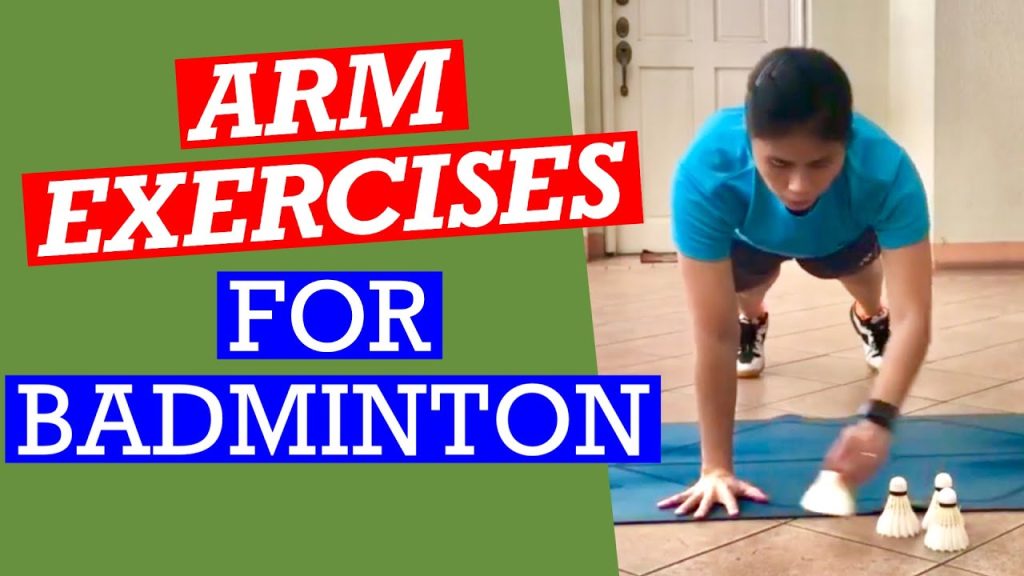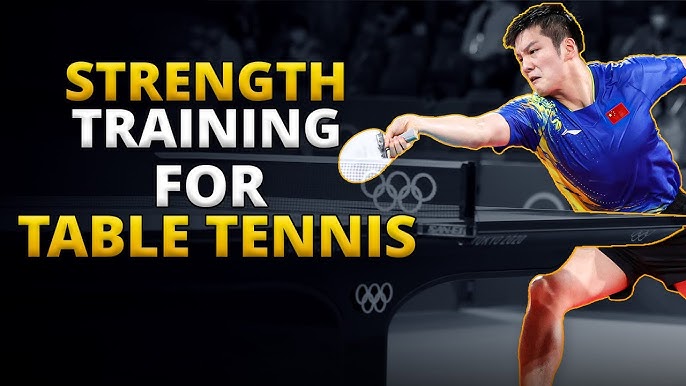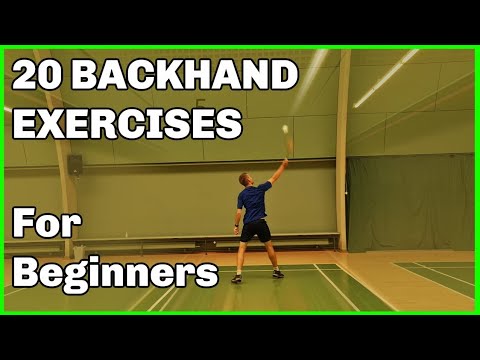Building strong arm muscles is key to excelling in badminton. It enhances power, precision, and endurance.
Badminton is a sport that demands agility, speed, and strength. Among these, arm strength plays a crucial role in delivering powerful smashes and swift shots. To outplay your opponents, you need more than just skill; you need well-trained arms. Whether you’re a beginner or a seasoned player, focusing on arm strength can significantly boost your performance.
Strong arms help in maintaining control and stamina during intense rallies. This blog will guide you through effective badminton arm strength training methods. Get ready to elevate your game with these essential exercises.

Credit: yumo.ca
Importance Of Arm Strength In Badminton
Badminton is a sport that demands agility, speed, and strength. Among these, arm strength holds a significant place. Strong arms enhance your ability to deliver powerful shots. It also helps in maintaining control during long rallies. Understanding the importance of arm strength can elevate your game.
Impact On Performance
Arm strength directly influences your performance. It helps in executing powerful smashes. Strong arms also aid in precise drop shots. Every shot requires a different level of force. Stronger arms provide better control over this force. This leads to more accurate and effective shots. Your overall game improves with enhanced arm strength.
Injury Prevention
Injuries are common in badminton. Strong arms can help reduce the risk of injuries. They provide better support to your joints. This reduces the strain during intense matches. Strong muscles also recover faster from minor injuries. This keeps you on the court for longer. Consistent training strengthens not just muscles but also tendons and ligaments.
Basic Anatomy Of The Arm Muscles
Understanding the basic anatomy of the arm muscles is crucial for improving your badminton game. Your arm muscles play a key role in delivering powerful and accurate strokes. Let’s dive into the main muscles involved and their roles in badminton.
Key Muscles Involved
Several muscles in your arm work together to perform various badminton strokes. Here are the primary ones:
| Muscle | Location | Function |
|---|---|---|
| Biceps Brachii | Front of upper arm | Flexes the elbow |
| Triceps Brachii | Back of upper arm | Extends the elbow |
| Deltoid | Shoulder | Raises the arm |
| Forearm Flexors | Front of forearm | Flexes the wrist |
| Forearm Extensors | Back of forearm | Extends the wrist |
Role In Badminton Strokes
The arm muscles play various roles in badminton strokes. Here’s how each muscle contributes:
- Biceps Brachii: It helps in quick, sharp movements. Essential for net shots and lifting the shuttlecock.
- Triceps Brachii: Important for powerful smashes. It extends the arm to make contact with the shuttlecock.
- Deltoid: Used for overhead shots. Helps in raising and rotating the arm.
- Forearm Flexors: Important for grip strength. They help in controlling the racket during strokes.
- Forearm Extensors: Assist in backhand shots. They stabilize the wrist during stroke execution.
Understanding these muscles and their functions can help you tailor your training. Focus on strengthening these muscles to improve your performance.
Warm-up Exercises
Warm-up exercises are essential for badminton arm strength training. These exercises prepare your muscles and joints for intensive workouts. An effective warm-up session reduces injury risks and improves performance. Here, we will cover two key components of a warm-up routine: dynamic stretches and specific arm warm-ups.
Dynamic Stretches
Dynamic stretches involve active movements that increase blood flow. They improve flexibility and mobility.
- Arm Circles: Extend your arms to the sides. Make small circles, gradually increasing the size. Perform for 30 seconds.
- Shoulder Rolls: Rotate your shoulders forward and backward. Do 10 repetitions each.
- Torso Twists: Stand with feet shoulder-width apart. Twist your torso to the left, then to the right. Repeat 15 times.
Specific Arm Warm-ups
Specific arm warm-ups focus on the muscles used in badminton. These exercises target the shoulders, biceps, and triceps.
- Resistance Band Pulls: Hold a resistance band with both hands. Pull it apart until your arms are fully extended. Perform 15 repetitions.
- Push-Ups: Do regular push-ups to engage your entire upper body. Aim for 10-15 repetitions.
- Forearm Rotations: Hold a lightweight dumbbell. Rotate your forearm from palm up to palm down. Do 12 repetitions on each arm.
Incorporate these warm-up exercises into your routine. They will help you train effectively and safely.
Strength Training Exercises
Strength training exercises are essential for improving your badminton game. They help increase your power, speed, and endurance. By focusing on arm strength, you can enhance your shot accuracy and control. Let’s dive into some effective exercises.
Resistance Bands
Resistance bands are excellent for building arm strength. They are versatile and easy to use. Start with basic arm curls. Hold the band with both hands, stepping on it with your feet. Pull the band towards your shoulders. Repeat this for 15 reps.
Next, try tricep extensions. Hold the band behind your head with one hand. Extend your arm upwards, stretching the band. Do this for 15 reps on each arm.
Dumbbell Workouts
Dumbbell workouts are great for strength training. Begin with bicep curls. Hold a dumbbell in each hand. Curl your arms upwards towards your shoulders. Perform 15 reps for each arm.
For triceps, do overhead extensions. Hold a single dumbbell with both hands. Lift it behind your head and extend your arms upwards. Repeat for 15 reps.
Lastly, perform lateral raises. Hold a dumbbell in each hand. Raise your arms sideways to shoulder height. Lower them slowly. Do 15 reps.
Plyometric Drills
Plyometric drills are essential for enhancing badminton arm strength. These exercises focus on explosive power, speed, and agility. They are designed to mimic the quick movements required in badminton. By incorporating plyometric drills into your routine, you can improve your performance on the court.
Explosive Movements
Explosive movements are vital for badminton players. These exercises help generate quick and powerful actions. Some effective plyometric drills include:
- Medicine Ball Throws: Use a medicine ball to simulate the throwing motion of a badminton smash.
- Clap Push-Ups: Perform push-ups with a clap in between to increase arm strength and explosiveness.
- Box Jumps: Jump onto a sturdy box to build leg and arm power simultaneously.
These exercises focus on rapid muscle contractions. They enhance the ability to perform fast, powerful strokes.
Speed And Agility
Speed and agility are crucial for badminton. Plyometric drills can significantly improve these aspects. Some effective exercises include:
- Lateral Hops: Jump side to side over a line or small hurdle to improve lateral movement.
- Single-Leg Hops: Hop on one leg to build balance and agility.
- Agility Ladder Drills: Use an agility ladder to perform quick footwork patterns, enhancing coordination and speed.
These drills help in developing quick reflexes. They improve your ability to change direction rapidly during a game.
Incorporating these plyometric drills into your training routine can lead to significant improvements in your badminton arm strength. The drills enhance explosive movements, speed, and agility.
Core Integration
Badminton requires not only quick reflexes and agility but also considerable arm strength. A vital component of enhancing arm strength is core integration. The core muscles support your entire body, providing stability and power. Engaging your core effectively can significantly improve your performance on the court.
Importance Of Core
The core muscles consist of the abdomen, lower back, and pelvis. These muscles are crucial for maintaining balance and stability. A strong core can help you generate more power in your shots, making your arm movements more effective.
During rapid movements and sudden changes in direction, a stable core ensures better control. This stability reduces the risk of injury, allowing you to play more confidently and aggressively.
Exercises For Stability
Core exercises for stability are essential for badminton players. Planks are a simple yet effective exercise. They engage multiple muscle groups and improve overall strength.
Another useful exercise is the Russian twist. This exercise targets the oblique muscles, enhancing rotational strength. Strong obliques contribute to powerful smashes and quick directional changes.
Incorporating leg raises into your routine can also be beneficial. This exercise strengthens the lower abs, which are key for maintaining a stable posture during play.
Perform these exercises regularly to build a robust core. A strong core supports better performance and reduces the likelihood of injuries. Remember, consistency is key to seeing improvements.
Recovery And Rest
Recovery and rest are crucial for badminton arm strength training. While training is important, giving your muscles time to heal is equally vital. This ensures your muscles grow stronger and you avoid injuries. Proper recovery boosts overall performance on the court.
Importance Of Rest
Rest is essential for muscle repair and growth. After intense training, your muscles need time to rebuild. This is when they get stronger. Skipping rest can lead to fatigue and injuries.
Rest days help prevent overtraining. Overtraining can cause muscle strain and burnout. By resting, you give your body a chance to recover. This leads to better performance and endurance.
Effective Recovery Techniques
There are many ways to recover effectively. Here are some techniques:
- Stretching: Helps reduce muscle stiffness and improves flexibility.
- Hydration: Drink plenty of water to help muscle recovery.
- Nutrition: Eat protein-rich foods to support muscle repair.
- Ice Baths: Reduce inflammation and muscle soreness.
Using these techniques can enhance your recovery process. Stretching after workouts reduces muscle stiffness. Proper hydration ensures your muscles get the fluids they need. Eating the right foods, especially those rich in protein, aids in muscle repair. Ice baths can help reduce inflammation and soreness.
Consider incorporating these techniques into your routine. This will help you recover faster and train more effectively.
Sample Recovery Schedule
| Day | Activity |
|---|---|
| Monday | Training |
| Tuesday | Rest and Stretching |
| Wednesday | Training |
| Thursday | Hydration and Light Activity |
| Friday | Training |
| Saturday | Ice Bath and Nutrition |
| Sunday | Rest |
By following a balanced schedule, you can ensure your body gets the rest it needs. This will help you stay strong and avoid injuries. Always listen to your body and adjust your routine as needed.

Credit: yumo.ca
Nutrition For Muscle Growth
Proper nutrition plays a key role in muscle growth for badminton players. Eating the right foods can help build arm strength and improve performance. Understanding what to eat and drink is crucial for effective training. Let’s explore essential aspects of nutrition for muscle growth.
Protein Intake
Protein is vital for muscle repair and growth. Aim to include a source of protein in every meal. Good sources include chicken, fish, eggs, and beans. Dairy products like milk, cheese, and yogurt are also excellent. For vegetarians, tofu and lentils are great options. Consuming protein after a workout can help muscles recover faster. A protein shake is a convenient post-workout option.
Hydration Tips
Staying hydrated is essential for muscle function. Drink water throughout the day to keep muscles hydrated. Dehydration can lead to muscle cramps and fatigue. Aim for at least 8 glasses of water daily. During intense training, increase your water intake. Sports drinks can help replenish electrolytes lost through sweat. Avoid sugary drinks that can cause energy crashes.
Tracking Progress
Tracking your progress in badminton arm strength training is crucial. It helps you stay motivated and see tangible results. Regularly monitoring your improvements can ensure you are on the right track. Let’s explore how to effectively track your progress in arm strength training.
Setting Goals
Start by setting clear and achievable goals. Define what you want to accomplish with your arm strength training. Do you want to improve your smash power? Or do you aim to increase your endurance? Having specific targets will keep you focused and driven.
Write down your goals and revisit them regularly. This will remind you of your objectives and inspire you to keep pushing forward. Keep your goals realistic and adjust them as you progress.
Monitoring Improvements
Consistently monitor your improvements to gauge your progress. Use a journal or an app to record your training sessions. Note the weights used, the number of reps, and any challenges faced. This data will help you see patterns and identify areas needing more attention.
Take regular measurements of your arm strength. Use grip strength meters or perform specific strength tests. Compare these results over time to see improvements. Celebrate small victories to stay motivated and engaged in your training.
Visual feedback can be very effective. Take photos or videos of your training sessions. Review them to see changes in your form and strength. This will provide a clear picture of your progress and help you make necessary adjustments.

Credit: www.youtube.com
Frequently Asked Questions
What Exercises Improve Arm Strength For Badminton?
To improve arm strength for badminton, incorporate exercises like bicep curls, tricep dips, shoulder presses, and resistance band workouts. These exercises target key muscles used during play.
How Often Should I Train My Arms For Badminton?
Train your arms for badminton 2-3 times a week. Rest between sessions to prevent overuse injuries and promote muscle recovery.
Can Weight Lifting Help In Badminton?
Yes, weight lifting strengthens muscles crucial for powerful shots and quick movements. Focus on moderate weights and proper form.
Are Resistance Bands Good For Badminton Training?
Resistance bands are excellent for badminton training. They improve muscle strength, flexibility, and endurance, which are essential for the sport.
Conclusion
Strengthening your arm for badminton boosts your game. Strong arms improve power and control. Practice these exercises regularly. Stay consistent and patient. Results come with time and effort. Enjoy the journey and watch your skills grow. A strong arm can make a big difference.
Keep training, stay motivated, and play your best. Happy playing!



